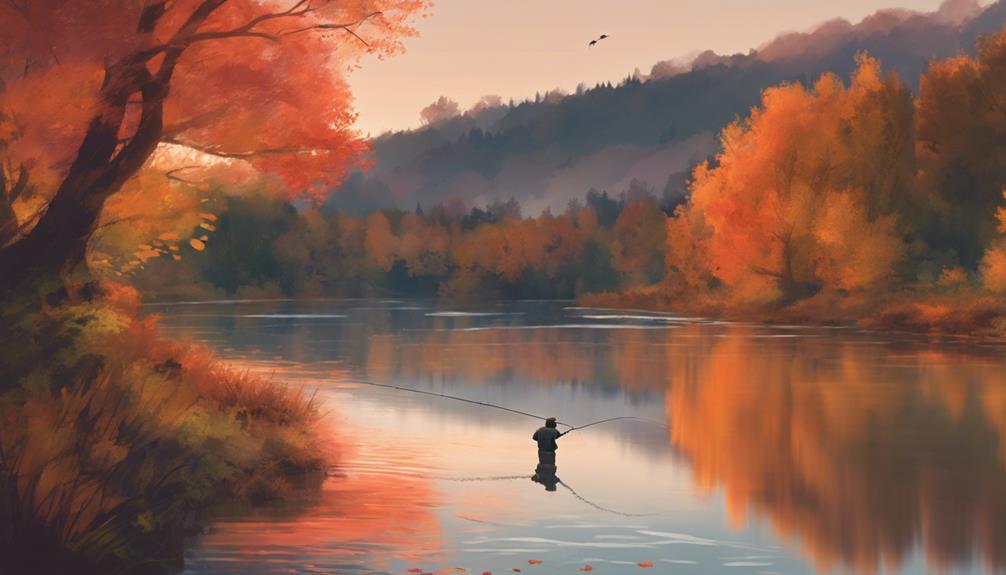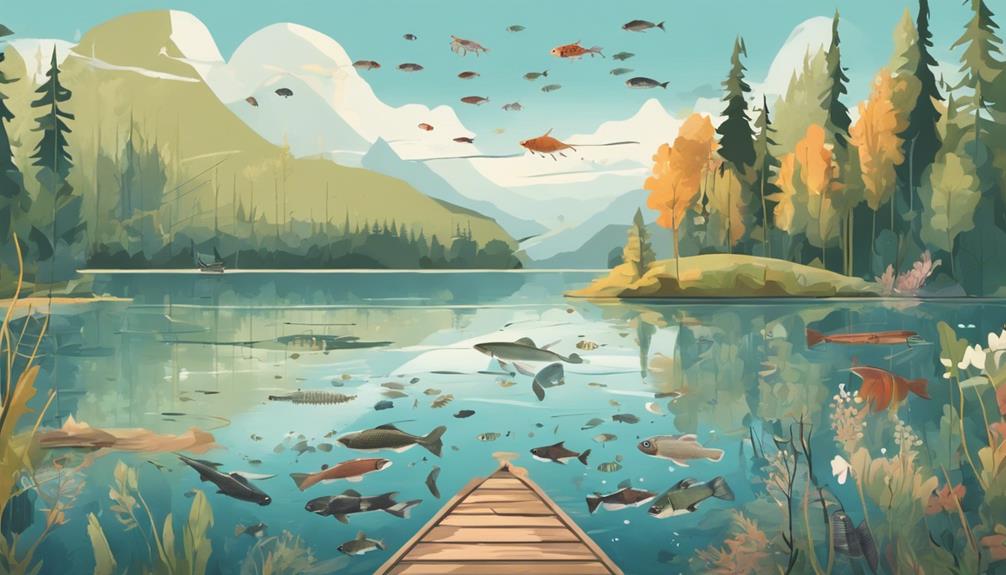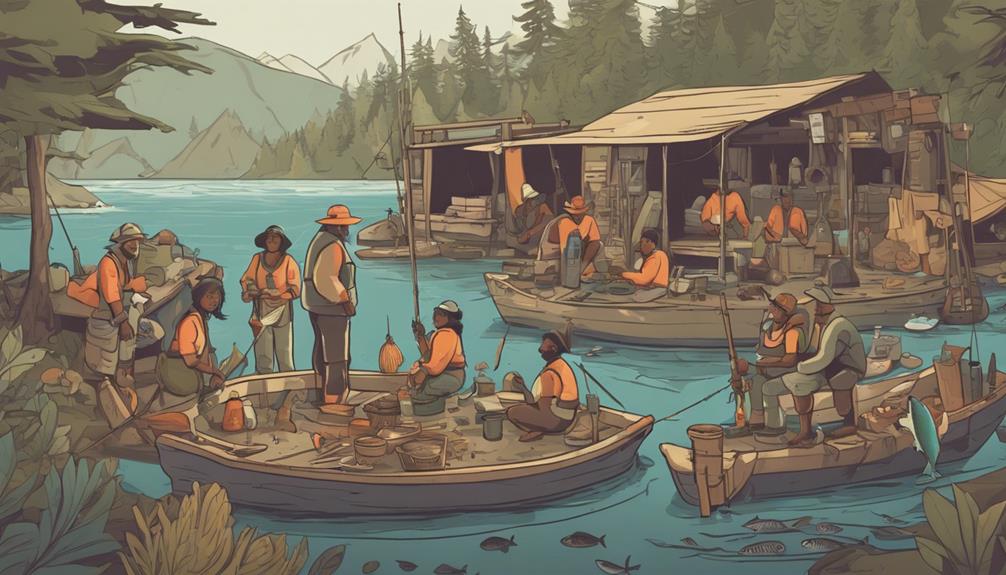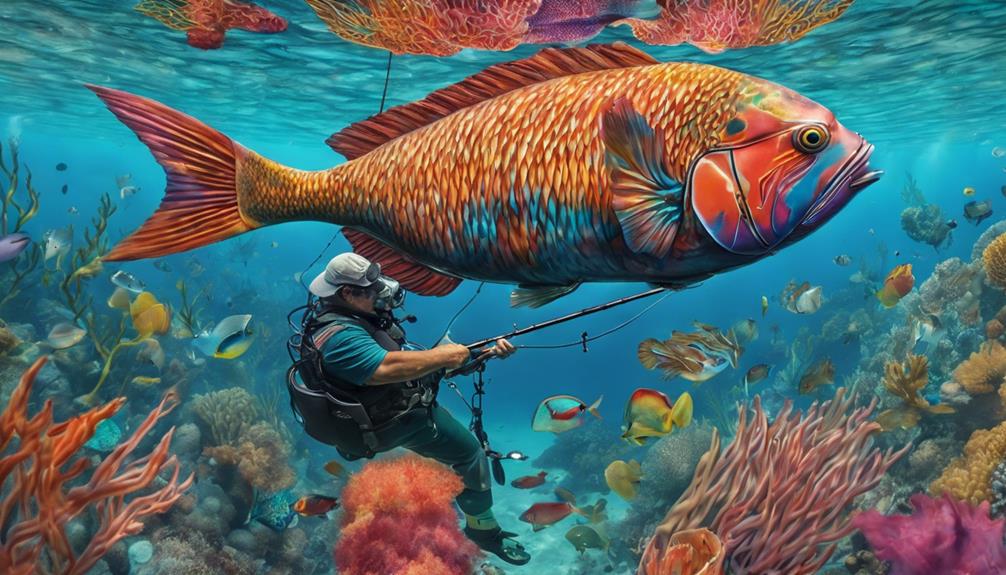Imagine the serene stillness of a misty lake at dawn, the surface barely rippling as you cast your line.
Each season brings its own challenges and rewards when it comes to angling for specific species. From the lively dance of spring bass to the icy depths where winter pike lurk, understanding the nuances of each season can significantly boost your success on the water.
So, whether you're seeking the thrill of a summer trout catch or the patience-testing winter perch, exploring these seasonal insights is key to honing your angling skills and reeling in that prized fish.
Spring Bass Fishing Tips
For successful spring bass fishing, position your boat near shallow waters with abundant vegetation. This is where bass tend to gather during the spring months, as they're attracted to the warmer water and the potential for finding food in these areas. When selecting your lures, opt for ones that mimic the movements of small baitfish or insects, as these will be most appealing to bass in this season. The key is to present your lure in a way that entices the bass to strike.
Water temperature plays a crucial role in spring bass fishing. As the temperatures rise, bass become more active, feeding more frequently to replenish their energy after the winter months. The ideal water temperature for spring bass fishing typically ranges between 55°F to 65°F. When the water reaches these temperatures, bass will start moving towards shallower areas, making them easier to target.
When it comes to lure selection, consider using crankbaits, spinnerbaits, or soft plastic worms to attract bass during the spring. Crankbaits can be effective for covering a lot of water quickly, while spinnerbaits are great for fishing in and around vegetation. Soft plastic worms are a classic choice that can be rigged in various ways to suit different fishing conditions. Experiment with different lures and presentations until you find what works best for the bass in your area during the spring season.
Summer Trout Fishing Techniques
To enhance your success in summer trout fishing, focus on adjusting your techniques to match the behavior of trout during this warmer season. Trout tend to seek cooler, oxygen-rich waters during summer, making stream fly fishing a productive method. When targeting trout in lakes, focusing on lake shorelines can also yield great results.
Summer Trout Fishing Techniques:
- Use Stream Fly Fishing: Trout in streams seek out faster, cooler waters during the summer months, making stream fly fishing an effective technique.
- Focus on Lake Shorelines: Trout in lakes often move closer to shorelines in search of food and cooler temperatures, presenting a great opportunity for anglers.
- Experiment with Different Fly Patterns: Be willing to try various fly patterns to see what the trout are actively feeding on during the summer months.
- Fish Early Mornings or Late Evenings: Trout are more active during the cooler parts of the day, so fishing early mornings or late evenings can increase your chances of success.
- Stay Stealthy: In low water conditions, trout can be easily spooked. Approach the fishing spot quietly and avoid making sudden movements to prevent scaring off the fish.
Fall Walleye Angling Strategies
Optimize your chances of catching walleye in the fall by implementing strategic angling techniques that capitalize on their seasonal behavior shifts. During the fall, walleye exhibit different feeding patterns and behaviors as they prepare for the upcoming winter. To increase your success rate, consider incorporating jigging techniques into your angling strategy. Jigging can be particularly effective during the fall months when walleye are more likely to be found near the bottom in search of prey like perch or shad. Use a jig with live bait or soft plastic trailers to entice walleye into striking.
In addition to jigging, trolling tactics can also be highly productive for targeting walleye in the fall. Trolling allows you to cover a larger area of water and locate schools of walleye that may be actively feeding. Consider using crankbaits or spinner rigs at varying depths to determine the most effective presentation for the day. Pay attention to your trolling speed and make adjustments until you find the optimal pace that triggers strikes.
When targeting walleye in the fall, it's essential to adapt to their changing behavior and preferences. By incorporating jigging techniques and trolling tactics into your angling repertoire, you can increase your chances of landing a trophy walleye during this season of transition.
Winter Pike Fishing Secrets
Discover the hidden techniques for successful winter pike fishing. When the cold weather sets in, ice fishing for pike can be an exhilarating experience. To maximize your chances of a successful winter pike fishing expedition, consider the following tips:
- Use Tip Ups: Tip ups are a popular tool for ice fishing pike. Set them up with large baitfish like smelt or suckers to attract the attention of these voracious predators.
- Find the Right Location: Look for areas with vegetation or drop-offs where pike are likely to be lurking. Using a fish finder can also help you locate schools of pike under the ice.
- Experiment with Depths: Pike can be found at varying depths during the winter months. Try fishing at different depths until you find where the pike are actively feeding.
- Stay Mobile: Unlike in warmer months, pike can be more spread out under the ice. Stay mobile and drill multiple holes to increase your chances of finding active fish.
- Be Patient: Winter pike fishing requires patience. Pike can be less active in the cold water, so be prepared to wait for the opportunity to hook into a big one.
Springtime Catfish Catching Guide
For successful catfish catching in the springtime, understanding their behavior and preferred habitats is key. Catfish are more active in the spring as they move towards shallow waters to feed and spawn. To increase your chances of a successful catch, consider the following tips.
When it comes to catfish bait choices, opt for stink baits, chicken livers, worms, or cut bait like shad or bluegill. These baits have strong scents that attract catfish, especially in murky waters where visibility is low. Make sure to use sharp hooks and sturdy lines, as catfish are known for their strong and sudden strikes.
In the springtime, catfish hotspots include areas with submerged structures like fallen trees, rocks, or river bends where the water is deeper. Look for shallow flats near deeper channels where catfish might be foraging for food. Additionally, pay attention to areas with muddy bottoms, as catfish tend to stir up the mud while feeding.
When targeting catfish in the spring, try fishing during dawn or dusk when they're most active. Use a slip bobber or bottom rig to present your bait at the right depth. By understanding catfish behavior and choosing the appropriate bait, you can improve your chances of a successful catch during the spring season.
Summer Crappie Fishing Tactics
During the summer months, targeting crappie in their preferred habitats can significantly increase your chances of a successful catch. To make the most of your summer crappie fishing experience, consider the following tactics:
- Locate the Thermocline: Hot weather crappie tend to seek out cooler waters, often congregating near the thermocline where the temperature and oxygen levels are just right.
- Early Morning and Late Evening: Summer slab tactics often involve fishing during the cooler parts of the day when crappie are more active near the surface. Early mornings and late evenings can be prime times for a successful catch.
- Use Light Tackle: Opt for light tackle when targeting crappie in the summer. Light lines, small jigs, and live bait can be more effective in enticing bites from these finicky fish.
- Focus on Structure: Crappie are structure-oriented fish, especially in the summer when they seek shelter from the heat. Target submerged trees, brush piles, and rocky outcrops for the best results.
- Stay Mobile: Don't hesitate to move around until you locate active fish. Crappie can be nomadic during the summer months, so staying mobile and trying different spots can pay off in landing a good haul.
Autumn Salmon Angling Hacks

As the temperatures cool and the leaves start to change, your focus shifts to mastering autumn salmon angling hacks for a successful fishing season. Autumn is a prime time for salmon fishing, and knowing the right techniques can make all the difference.
When targeting autumn salmon, riverbank casting techniques can be highly effective. Look for areas along the riverbank where salmon are likely to gather, such as deep pools or eddies. Cast your line upstream and let the current carry your bait or lure towards these areas where the salmon are holding.
In addition to riverbank casting techniques, mastering deep water drifts is crucial for autumn salmon angling success. As the season progresses, salmon tend to move into deeper waters as they prepare for spawning. To target these deep-water salmon, consider using downriggers or lead core lines to get your bait or lure to the right depth. Pay attention to your sonar to locate schools of salmon in deeper waters and adjust your drift accordingly to increase your chances of a bite.
Winter Perch Fishing Essentials
Mastering the art of ice fishing for winter perch requires patience, precision, and the right gear. When heading out onto the frozen waters in search of these elusive fish, it's essential to be well-prepared.
Here are some key tips to enhance your winter perch fishing experience:
- Ice Fishing Essentials: To successfully catch winter perch, make sure you have the appropriate ice fishing gear, such as an auger, ice shelter, and tip-ups. These tools will help you navigate the icy terrain and increase your chances of a successful catch.
- Stay Warm: Dress in layers to combat the cold weather. Thermal clothing, waterproof boots, and gloves are essential to keep you warm and comfortable during long hours on the ice.
- Locate the Fish: Use a fish finder or drill test holes to locate schools of perch beneath the ice. Once you've found a promising spot, set up your equipment and be patient.
- Use Light Tackle: Winter perch can be finicky, so using light tackle and small jigs or spoons is recommended. This will help you entice bites from these cautious fish.
- Cold Weather Tactics: Adjust your fishing techniques to suit the cold weather conditions. Slow down your presentation and be prepared to wait longer for bites. Patience is key when fishing for winter perch.
Frequently Asked Questions
How Can I Effectively Target Carp During the Spring Season?
To effectively target carp during the spring season, focus on their behavior and use specific bait tactics.
Spring is a time when carp are more active and feeding. Opt for bait like sweetcorn, boilies, or bread crusts to attract them. Look for shallow areas with vegetation where carp tend to gather during this season.
What Are Some Unique Strategies for Catching Muskie in the Summer Months?
In the summer months, when targeting muskie, you can try some unique strategies.
For topwater tactics, consider using large surface lures like prop baits or walk-the-dog style lures during low light conditions or in the early morning and evening. Night fishing can also be productive for muskie.
Additionally, try fishing along weedline ambush points or deep water trolling to entice these elusive predators during the warmer months.
Are There Any Specialized Techniques for Catching Sturgeon in the Fall?
To catch sturgeon in the fall, try different tactics like using fresh bait and fishing in deeper waters where they gather. Adjust your gear for the season, like heavier lines and sturdy hooks.
Stay patient and be ready for a fight when you hook one. By understanding fall sturgeon behavior and adapting your approach, you increase your chances of landing one during the autumn months.
What Are Some Tips for Ice Fishing for Panfish Like Bluegill During the Winter?
For winter tactics when ice fishing for panfish like bluegill, focus on using small jigs or tiny live baits like waxworms. Look for them in shallow areas near vegetation or drop-offs.
Ice shelters can keep you warm and make the experience more enjoyable. Make sure to dress warmly and bring all necessary gear for safety.
Stay patient and adjust your techniques until you find what works best for the conditions.
How Can I Improve My Success Rate When Fishing for Catfish in the Springtime?
To boost your catfish catch rate in the spring, focus on bait selection and location scouting. Opt for natural baits like worms or chicken liver and search for spots with slow-moving waters and underwater structures.
Use a sturdy rod setup with a strong line to handle potential big catches. Experiment with presentation techniques such as bottom fishing or float rigs to entice catfish effectively.
These strategies can up your game when targeting catfish in the spring.
Conclusion
Now that you have learned species-specific angling tips for each season, you're armed with the knowledge to have successful fishing outings year-round.
Remember to adapt your techniques based on the time of year and the species you're targeting.
By following these insights, you can increase your chances of landing a big catch and enjoying the thrill of the sport of fishing.
Happy angling!



